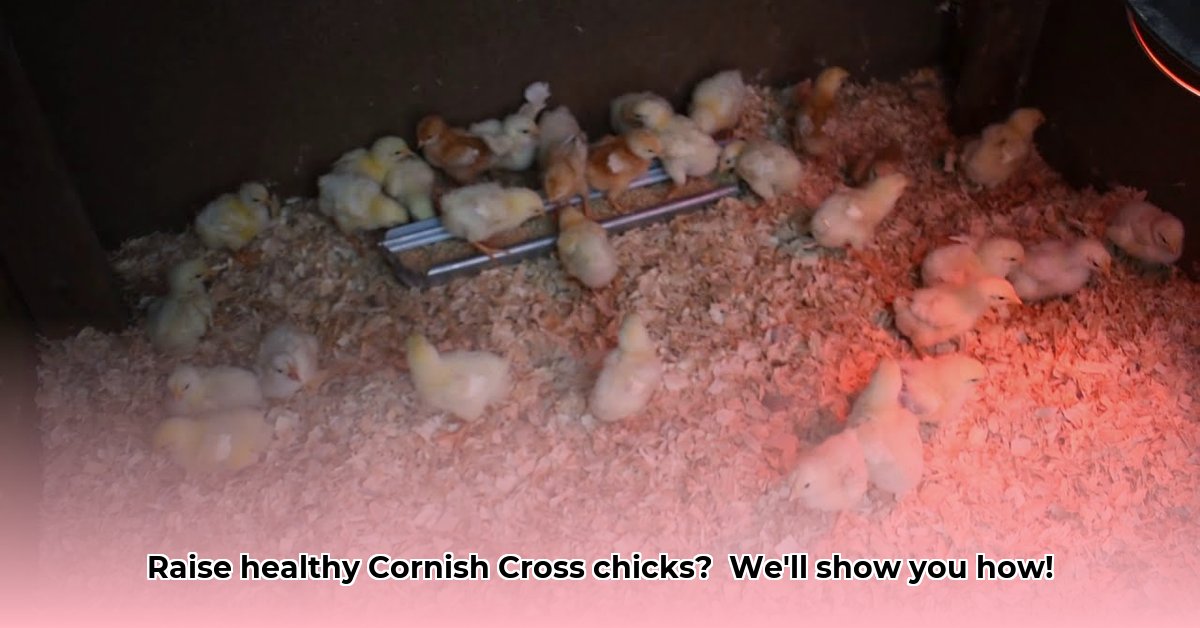
Raising Cornish Cross chickens can be both rewarding and environmentally responsible. This guide provides actionable steps to build a thriving and sustainable poultry farm, whether you're a seasoned farmer or a beginner. We'll cover everything from chick selection to waste management, incorporating best practices to minimize environmental impact and maximize your success. For additional resources on housing options, check out these chicken run options.
Choosing Your Chicks and Establishing Your Sustainable System
Your journey starts with healthy chicks. Source your Cornish Cross chicks from reputable hatcheries, such as those found at Tractor Supply, prioritizing disease resistance and focusing on minimizing feed conversion ratios (FCR) – the amount of feed needed to produce a pound of meat. A lower FCR translates to less feed, reducing your environmental footprint and feed costs. Buying locally reduces transportation emissions.
Did you know that a 10% reduction in FCR can significantly reduce your farm's environmental impact?
Housing Your Flock: Prioritizing Natural Ventilation and Efficiency
Proper housing is crucial for both bird welfare and sustainability. Mobile poultry housing units are a game-changer, allowing for frequent relocation to fresh pasture, minimizing overgrazing and promoting soil regeneration. Prioritize natural ventilation – good airflow reduces harmful ammonia buildup (a greenhouse gas). Maximize natural light; if supplemental lighting is needed, use energy-efficient LEDs.
"Properly designed housing can drastically reduce the need for energy-intensive artificial ventilation systems," says Dr. Anya Sharma, Avian Veterinarian at the University of California, Davis.
Sustainable Feed Management: Minimizing Your Environmental Footprint
Feed is a major factor in the environmental impact of broiler farming. Prioritize sustainable options.
Sourcing and Formulating Sustainable Feed
- Local Sourcing: Buy locally sourced feed ingredients whenever possible to reduce transportation emissions.
- Alternative Protein Sources: Consider incorporating alternative protein sources like insect meal or algae. These have significantly lower greenhouse gas emissions than traditional soy or fishmeal.
- Precise Feed Management: Accurate feed weighing and monitoring ensures optimal growth while minimizing waste. This translates to less feed needed and less waste generated.
A study by the University of Illinois found that insect-based feed reduced greenhouse gas emissions by up to 40% compared to traditional soy-based feed.
Waste Management and Composting: Creating a Closed-Loop System
Manure management is essential for sustainable farming. The volume of manure produced can pollute water sources and increase greenhouse gas emissions.
Composting Your Chicken Manure
Composting chicken manure transforms a potential pollutant into a valuable fertilizer, reducing odor and minimizing pathogen risks. Invest in an appropriate composting system for your flock size, ensuring proper aeration and moisture levels for optimal decomposition.
Effective composting reduces odor by up to 95%.
Animal Welfare and Disease Management: A Foundation for Sustainability
Sustainable farming centers on animal welfare. Provide ample space, clean water, and environmental enrichment.
Implementing Biosecurity Protocols
Overcrowding stresses birds, increasing disease susceptibility and productivity reduction. Biosecurity protocols—sanitation, disinfection, and illness monitoring—are vital to prevent disease spread. Early detection and intervention minimize economic losses and improve overall flock health.
"Regular health checks are as crucial as regular feeding. Early intervention is paramount in minimizing disease outbreaks," states Dr. John Miller, Poultry Specialist at Purdue University.
Real-World Example: Green Acres Farm’s Success Story
Green Acres Farm, a successful Cornish Cross farm, demonstrates the viability of sustainable practices. They used mobile housing units, minimized pasture degradation, composted manure and sourced feed locally, incorporating insect meal into their feed, significantly lowering their carbon footprint and creating a healthy, productive flock. Their success proves that sustainable farming isn't just environmentally responsible—it's economically sound.
Conclusion: Building Your Sustainable Cornish Cross Broiler Farm
Sustainable Cornish Cross broiler farming demands a holistic approach encompassing feed management, waste reduction, animal welfare, and responsible sourcing. By implementing the strategies discussed, your environmental impact decreases while ensuring the health and well-being of your flock. Remember, sustainable farming is an investment in a resilient, economically viable, and environmentally responsible business. The journey involves challenges, but the payoff—a healthy flock, a cleaner environment, and a thriving business—makes the effort worthwhile.